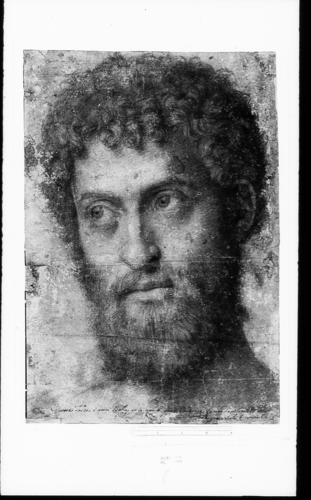The head of a man c. 1520-30
Black and white chalks on blue paper, much damaged | 37.6 x 26.0 cm (sheet of paper) | RCIN 990088
-
No completely convincing attribution has been found for this large and impressive head study. The inscription, apparently of the sixteenth century, shows that an early collector judged it to be Florentine, and there is something about the decorative drawing of the hair (so far as can be judged) that does not allow this opinion to be dismissed out of hand. But the use of blue paper is much more common in northern Italy, and Creighton Gilbert has repeatedly claimed the drawing as the work of Girolamo Savoldo. Savoldo’s three decades based in Venice resulted in relatively few paintings (many of which are repetitions) and even fewer drawings, nearly all which are of this type: black chalk heads on blue paper. Gilbert claimed that the present sheet was a self-portrait, based on the supposed facial resemblance to other presumed self-portraits: a Prophet (who holds a scroll bearing Savoldo’s signature) in Vienna; San Liberale at the far right of the Pala di San Nicolòin Treviso; and the so-called ‘Gaston de Foix’ in the Louvre. While the identification of the Vienna painting as a self-portrait is very plausible, and the saint in the Treviso altarpiece does seem to depict the same person, there is a danger of identifying any similarly bearded, bushy-haired man in Savoldo’s oeuvre as a self-portrait. ‘Gaston de Foix’ has a different nose, short and fleshy rather than long and bony, and the subject of the Windsor drawing seems different again, with a stronger chin, broader lower face and less deep-sunk eyes than the Vienna figure.
The attribution to Savoldo has not been generally accepted, and is here followed only tentatively, for the fine combination of breadth of concept with tightness of detail is not characteristic of the artist. Lucco ascribed the drawing to Bernardino Licinio, but while the drawing is most probably by some Venetian artist around 1520-30, it is broader and more free than the rather flatly conceived heads of Licinio’s many painted portraits.
Inscribed below: Questa Testa Å assai Bella et io non la posso Giudicare se non diun Gran Mano / Della gran scola Fiorentina
Catalogue entry adapted from The Art of Italy in the Royal Collection: Renaissance and Baroque, London, 2007Provenance
Presumably in the Royal Collection by c.1810
-
Creator(s)
-
Medium and techniques
Black and white chalks on blue paper, much damaged
Measurements
37.6 x 26.0 cm (sheet of paper)
Object type(s)
Other number(s)










